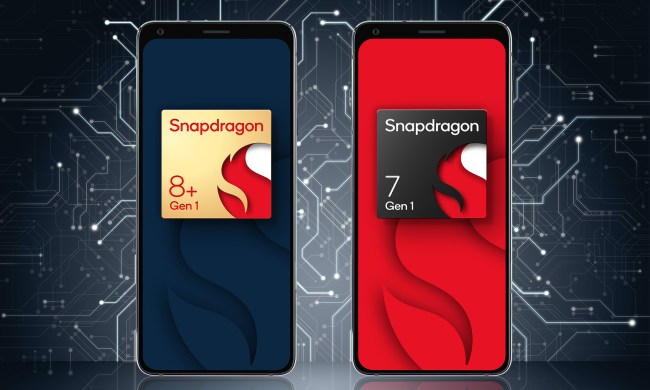
Qualcomm is not idly standing by, however, and in an attempt to cut off its encroaching rivals at their respective heads, it’s launching brand new Snapdragon chips — the kind destined for mobile devices — and smartphone hardware capable of astonishing LTE speeds.
First up is a trio of new Snapdragon chips: the 653, 626, and 427, bound for handsets of all prices and configurations.
The Snapdragon 653 comprises the same combination of four top-end ARM Cortex-A72 processors and low-power Cortex A53 as its predecessor, the 653, and the same Adreno 510 graphics chip. But it’s an improvement in subtle ways. Its processor, which now tops out at 1.95 GHz, performs up to 10 percent better than the 652, bumps the maximum amount of supported RAM from 4GB to 8GB, and sports Qualcomm’s newer X9 LTE modem with support for improved call quality — specifically of the Ultra HD Voice (EVS) over VoLTE variety. Rounding out those enhancements is 802.11ac MU-MIMO Wi-Fi, fast wireless capable of a blazing 6.9 Gbps.
The Snapdragon 626 may technically slot lower on Qualcomm’s processor totem pole, but it’s no slouch. It packs four Cortex-A53 cores and an Adreno 506 graphics chip that, thanks to a top clock speed of up to 2.2GHz, perform up to 10 percent better than those on the outgoing 625. Bluetooth 4.2 support is in tow, as is the same X9 LTE modem as its higher-end counterpart, the 653.
The decidedly low-end Snapdragon 427 holds its own, meanwhile. It’s slim pickings in terms of performance improvements — the 427 sports the same four Cortex-A53 cores and Adreno 308 GPU as the model before it, the 425 — but it has gained a notable addition in the area of connectivity — Qualcomm’s X9 LTE modem.
The new Snapdragon chips share more than Qualcomm’s modem in common. All feature Quick Charge 3.0, a feature which promises up to an 80-percent charge in as little as 35 minutes. And all support Qualcomm’s dual-camera Clear Sight technology.
That last bit is significant. Qualcomm’s calls Clear Sight a “processing solution” for phones with dual cameras, and that’s more or less accurate. Unlike the iPhone 7’s setup, which employs a secondary shooter for the purpose of simulating optical zooming, Clear Sight pairs a color camera sensor with a singular black-and-white sensor. Qualcomm contends that this delivers improvements in the areas of contrast, sharpness, and clarity, and more. One feature, “refocus,” allows the adjustment of an image’s focus by simultaneously capturing different focal lengths between the phones’ cameras. Another, “segmentation,” maps a pic’s foreground and background focus plans. And “fast autofocus” boosts the speed at which the cameras narrow on focus planes.
New Snapdragon chips weren’t the only products Qualcomm has announced. It took the wraps off a new top-of-the-line modem, the X16 LTE, which can reach speeds of up to 1Gbps using a combination of technologies. The firm has partnered with Telstra, Netgear, and Ericsson to bring it to market within the year, and Netgear will produce hardware to power a Wi-Fi hotspot on Australian carrier Telstra’s LTE network. Qualcomm said that in simulated testing environments, the chipset managed impressive speeds from 112 to 307Mbps, with a peak of 533Mbps.
Looking ahead, Qualcomm said its next-generation Snapdragon 800 series processor, due out in the first half of next year, will include the gigabit X16 modem. And it said its 5G-compatible Snapdragon X50, which uses the 28GHz millimeter wave band, could arrive as soon as 2018. (Qualcomm said it will test the technology at the 2018 Winter Olympics in Korea.)
Qualcomm also debuted a holistic solution for the burgeoning field of “connected cameras” — e.g., action cameras, 360-degree shooters, dashboard cams, and more. It’s a combination hardware-and-software platform built on the company’s Snapdragon 625 processor, and packs, as you might expect, a slew of wireless technologies including 4G, Wi-Fi, Bluetooth, and more. It runs a variant of Linux with support for deep learning and 4K encoding, and will arrive by the end of this year.


